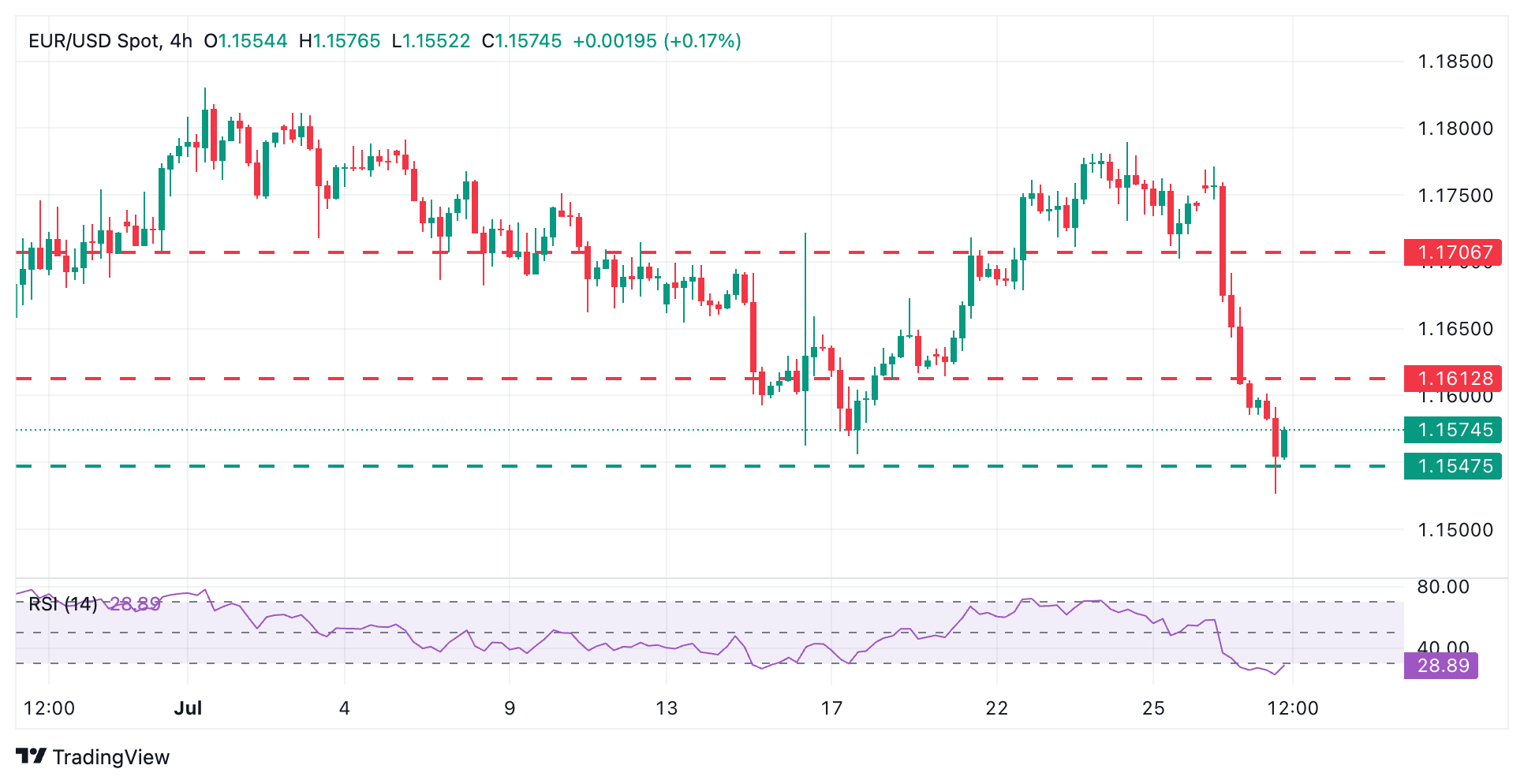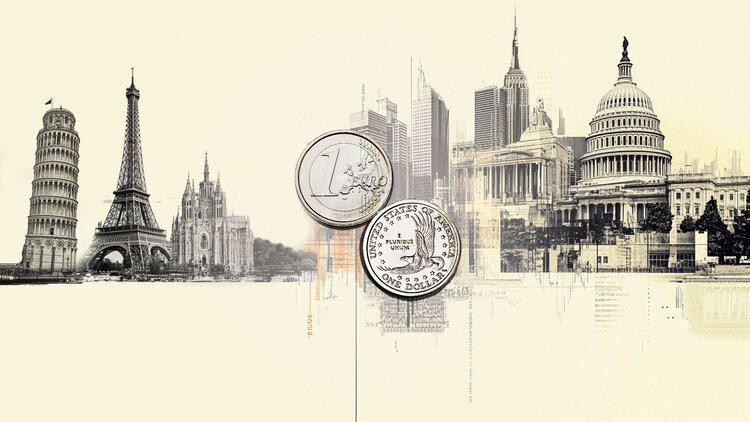The Euro corrects higher after a nearly 2% sell-off following the US-EU trade deal.EU member countries complain about the negative consequences for the Eurozone economy.The focus today is on the US Consumer Confidence and JOLTS Job Openings data.
EUR/USD pair remains on the defensive, although the pair has managed to bounce up from fresh one-month lows during the European morning session and return to previous ranges. The pair had lost nearly 2% from Monday’s highs as the details of the trade agreement between the United States (US) and the European Union (EU) came to light, revealing a rather unfavourable arrangement for European businesses.
The Euro (EUR) upside attempts were capped at 1.1600 on Tuesday’s Asian session, and the pair extended its decline again at the European session opening, to hit fresh multi-week lows right above 1.1525. before returning to 1.1565 at the time of writing.
In Europe, the European Commission is struggling to defend the pact with the US as the best possible solution amid mounting criticism from European capitals. French Prime Minister François Bayrou has called the deal a “submission”, and German Chancellor Friedrich Merz warned of “substantial damage ” to the domestic economy. All in all, not the deal Brussels was aiming for.
The US Dollar (USD), on the other hand, comes as the biggest winner from a raft of deals that have restored US commercial relations with its major trading partners, except Canada and Mexico, at least for now. The focus moves now to the macroeconomic front, with US Consumer Confidence and JOLTs Jobs Openings kicking off a data-packed week that includes the Federal Reserve’s (Fed) monetary policy decision on Wednesday and the all-important Nonfarm Payrolls (NFP) on Friday.
Euro PRICE Today
The table below shows the percentage change of Euro (EUR) against listed major currencies today. Euro was the strongest against the New Zealand Dollar.
USD
EUR
GBP
JPY
CAD
AUD
NZD
CHF
USD
0.35%
0.24%
0.07%
0.13%
0.28%
0.49%
0.31%
EUR
-0.35%
-0.12%
-0.33%
-0.22%
-0.06%
0.02%
-0.01%
GBP
-0.24%
0.12%
-0.18%
-0.10%
0.07%
0.15%
0.09%
JPY
-0.07%
0.33%
0.18%
0.05%
0.20%
0.34%
0.36%
CAD
-0.13%
0.22%
0.10%
-0.05%
0.09%
0.38%
0.19%
AUD
-0.28%
0.06%
-0.07%
-0.20%
-0.09%
0.10%
0.02%
NZD
-0.49%
-0.02%
-0.15%
-0.34%
-0.38%
-0.10%
-0.07%
CHF
-0.31%
0.01%
-0.09%
-0.36%
-0.19%
-0.02%
0.07%
The heat map shows percentage changes of major currencies against each other. The base currency is picked from the left column, while the quote currency is picked from the top row. For example, if you pick the Euro from the left column and move along the horizontal line to the US Dollar, the percentage change displayed in the box will represent EUR (base)/USD (quote).
foot
Daily digest market movers: The Euro, on the back foot after the US-EU trade dealThe trade deal between the US and EU averts a trade war but does not bring any benefit to the Eurozone economy. EU products will face 15% levies, which will erase their trade revenues. Apart from that, Europe has committed to invest EUR 600 billion in the US and buy EUR 750 billion of its Gas, leading to a significant capital flow that is likely to bleed the Euro.The US Dollar remains bid across the board. Recent data show the image of a strong economy, with a resilient labour market that justifies the Fed’s “wait and see” stance and has forced investors to dial back hopes of interest rate cuts for this year.Later today, the US Conference Board’s Consumer Confidence Index is expected to show a moderate improvement to 95.0 from last month’s 93.0. reading.At the same time, during Tuesday’s American session, the US JOLTS Jobs Openings is expected to show a moderate decline in demand from employees in July to 7.55 million, from June’s 7.769 million, but still at levels consistent with a healthy labour market.EUR/USD: A dead-cat bounce from oversold levels
The EUR/USD extends its decline in Tuesday’s European session. The pair has returned above 1.1555 support after hitting fresh monthly lows near 1.1525. This is likely to be a short-lived upside correction from oversold levels. Unless the fundamental background changes substantially, Euro rallies are likely to find sellers.
On the upside, if the pair manages to hold above the mentioned 1.1555 (July 17 low), the area between the intra-day high at 1.1600 and the July 21 low, at 1.1615, is likely to challenge bulls on potential upside attempts. Above this area, the next targets are 1.1680 (July 22 low) and the 1.1700 area (July 23 and 25 lows).
A bearish reaction below 1.1555 r might reach the psychological 1.1500 level. Below there, the June 23 low near 1.14 seems too far a target for today.
Euro FAQs
The Euro is the currency for the 19 European Union countries that belong to the Eurozone. It is the second most heavily traded currency in the world behind the US Dollar. In 2022, it accounted for 31% of all foreign exchange transactions, with an average daily turnover of over $2.2 trillion a day.
EUR/USD is the most heavily traded currency pair in the world, accounting for an estimated 30% off all transactions, followed by EUR/JPY (4%), EUR/GBP (3%) and EUR/AUD (2%).
The European Central Bank (ECB) in Frankfurt, Germany, is the reserve bank for the Eurozone. The ECB sets interest rates and manages monetary policy.
The ECB’s primary mandate is to maintain price stability, which means either controlling inflation or stimulating growth. Its primary tool is the raising or lowering of interest rates. Relatively high interest rates – or the expectation of higher rates – will usually benefit the Euro and vice versa.
The ECB Governing Council makes monetary policy decisions at meetings held eight times a year. Decisions are made by heads of the Eurozone national banks and six permanent members, including the President of the ECB, Christine Lagarde.
Eurozone inflation data, measured by the Harmonized Index of Consumer Prices (HICP), is an important econometric for the Euro. If inflation rises more than expected, especially if above the ECB’s 2% target, it obliges the ECB to raise interest rates to bring it back under control.
Relatively high interest rates compared to its counterparts will usually benefit the Euro, as it makes the region more attractive as a place for global investors to park their money.
Data releases gauge the health of the economy and can impact on the Euro. Indicators such as GDP, Manufacturing and Services PMIs, employment, and consumer sentiment surveys can all influence the direction of the single currency.
A strong economy is good for the Euro. Not only does it attract more foreign investment but it may encourage the ECB to put up interest rates, which will directly strengthen the Euro. Otherwise, if economic data is weak, the Euro is likely to fall.
Economic data for the four largest economies in the euro area (Germany, France, Italy and Spain) are especially significant, as they account for 75% of the Eurozone’s economy.
Another significant data release for the Euro is the Trade Balance. This indicator measures the difference between what a country earns from its exports and what it spends on imports over a given period.
If a country produces highly sought after exports then its currency will gain in value purely from the extra demand created from foreign buyers seeking to purchase these goods. Therefore, a positive net Trade Balance strengthens a currency and vice versa for a negative balance.

